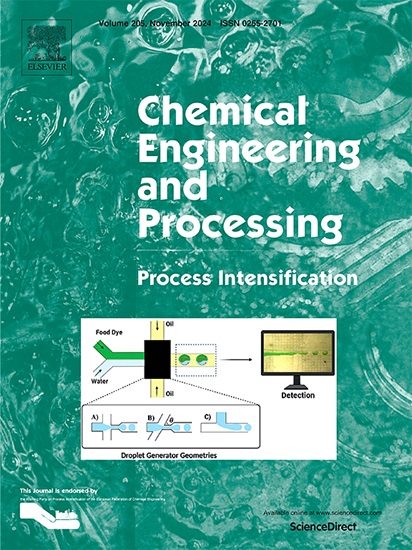Performance evaluation of helical tangential porous tube-in-tube microchannel mixer: Effect of cross-sectional area ratio and volumetric flow rate ratio
IF 3.8
3区 工程技术
Q3 ENERGY & FUELS
Chemical Engineering and Processing - Process Intensification
Pub Date : 2025-03-28
DOI:10.1016/j.cep.2025.110296
引用次数: 0
Abstract
The tube-in-tube microchannel mixer (TMM) is a passive micromixer primarily applied in chemical engineering and pharmaceutical fields. This study investigates the performance optimization of a helical tangential porous tube-in-tube microchannel mixer (HTP-TMM) using computational fluid dynamics (CFD) simulations. A critical structural parameter, the cross-sectional area ratio (Ra), defined as the ratio of the annular microchannel cross-sectional area to the total micropore cross-sectional area, was introduced. The effects of various Ra and volumetric flow rate ratios (Rf) on mixing efficiency, turbulent kinetic energy, pressure drop, and mixing energy cost were evaluated across flow rates ranging from 10 to 300 mL/min. Results indicate that Ra = 1.5 demonstrates higher mixing efficiency and turbulent kinetic energy at low flow rates. Decreasing Rf improves mixing efficiency and turbulent kinetic energy, with optimal mixing performance occurring at Rf = 1. Additionally, larger Ra and smaller Rf values induce higher pressure drops, with maximum recorded values of 23,449 Pa for Ra = 2 and 19,990 Pa for Rf = 1, both within acceptable ranges for practical applications. Moreover, varying Ra minimally affects mixing energy cost, while increasing Rf raises mixing energy cost. These findings provide valuable guidance for TMM design and application in chemical engineering.

螺旋切向多孔管中管微通道混合器性能评价:截面积比和容积流量比的影响
管中微通道混合器(TMM)是一种主要应用于化工和制药领域的无源微混合器。利用计算流体动力学(CFD)模拟研究了螺旋切向多孔管中管微通道混合器(HTP-TMM)的性能优化。引入了一个关键的结构参数——横截面积比(Ra),定义为环形微通道横截面积与总微孔横截面积之比。在10 ~ 300 mL/min的流量范围内,评估了不同Ra和体积流量比(Rf)对混合效率、湍流动能、压降和混合能成本的影响。结果表明,在低流速下,Ra = 1.5具有较高的混合效率和湍流动能。减小Rf可提高混合效率和湍流动能,在Rf = 1时混合性能最佳。此外,较大的Ra和较小的Rf值会导致较高的压降,Ra = 2时最大记录值为23,449 Pa, Rf = 1时最大记录值为19,990 Pa,均在实际应用的可接受范围内。Ra的变化对混合能量成本的影响最小,而Rf的增加使混合能量成本升高。这些发现对TMM在化工中的设计和应用具有重要的指导意义。
本文章由计算机程序翻译,如有差异,请以英文原文为准。
求助全文
约1分钟内获得全文
求助全文
来源期刊
CiteScore
7.80
自引率
9.30%
发文量
408
审稿时长
49 days
期刊介绍:
Chemical Engineering and Processing: Process Intensification is intended for practicing researchers in industry and academia, working in the field of Process Engineering and related to the subject of Process Intensification.Articles published in the Journal demonstrate how novel discoveries, developments and theories in the field of Process Engineering and in particular Process Intensification may be used for analysis and design of innovative equipment and processing methods with substantially improved sustainability, efficiency and environmental performance.

 求助内容:
求助内容: 应助结果提醒方式:
应助结果提醒方式:


